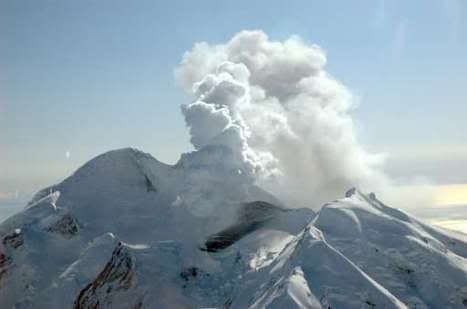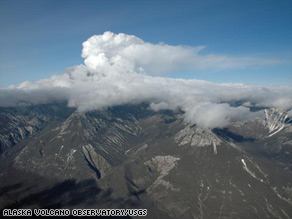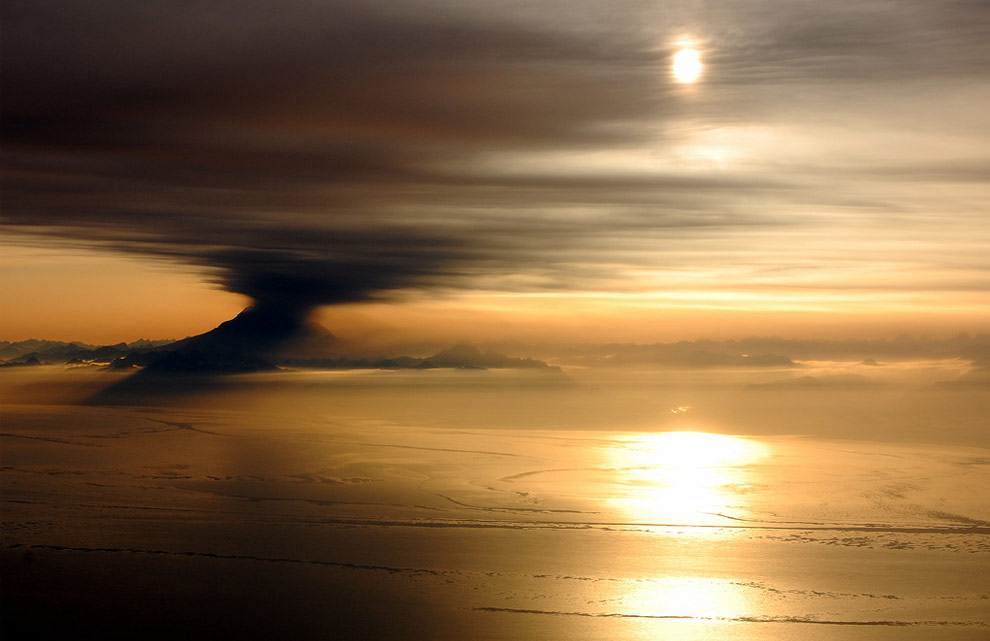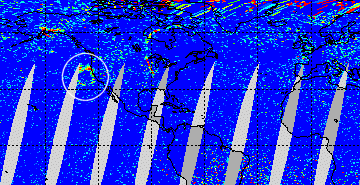WKN Weer, Klimaat en Natuurrampen
Lees alles over het onstuimige weer op onze planeet, volg orkanen en tornado's, zie hoe vulkanen uitbarsten en hoe Moeder Aarde beeft bij een aardbeving. Alles over de verwoestende kracht van onze planeet en tal van andere natuurverschijnselen.



Gewoon in Amsterdam, maar als dat spul in de stratosfeer terecht komt zorgt de jetstream er wel voor dat de rest van het halfrond er ook van kan profiteren.quote:
zie bijvoorbeeld dit artikel van na de uitbarsting van de Kasatochi vorig jaar, ook in Alaska:
http://www.livescience.co(...)volcano-sunsets.html
die rookpluim kwam "maar" tot 10 km.


nu wel aangepast, dankje.quote:Op maandag 23 maart 2009 15:40 schreef Bradley33 het volgende:
Op de FP staat trouwens dat Anchorage de hoofdstad is van Alaska, maar dat moet Juneau zijn. Maar het wordt niet veranderd ondanks de comments.


quote:Op maandag 23 maart 2009 16:04 schreef Ared het volgende:
[..]
Gewoon in Amsterdam, maar als dat spul in de stratosfeer terecht komt zorgt de jetstream er wel voor dat de rest van het halfrond er ook van kan profiteren.
zie bijvoorbeeld dit artikel van na de uitbarsting van de Kasatochi vorig jaar, ook in Alaska:
http://www.livescience.co(...)volcano-sunsets.html
die rookpluim kwam "maar" tot 10 km.
Zie ook
Vulkaanstof zorgt voor rode schemergloed


hlnquote:In Alaska is de vulkaan Mt. Redoubt in vier explosies uitgebarsten. De berg spuwde een rookpluim ongeveer 1.500 kilometer hoog de lucht in. De vulkaan ligt dichtbij enkele belangrijke steden en volgens geologen was dit een vrij zware uitbarsting. In de steden is er voorlopig nog geen sprake van asneerslag. Gevaar is er niet, maar de geologen benadrukken dat het nog vroeg is.
Verse magma?
Sinds eind januari wordt Mt. Redoubt nauwkeurig in het oog gehouden uit vrees voor een nakende uitbarsting. Vorige week werd het alarmpeil voor het eerst verminderd. Geologen zullen nu onderzoeken of de stoom van deze uitbarsting wijst op verse magma of slechts de restanten van vorige uitbarstingen bevat.
KLM in problemen
Op 15 december 1989 veroorzaakte Mt. Redoubt bijna een ramp. De vulkaan stuurde toen een rookpluim ongeveer 240 kilometer hoog de lucht in. Een vliegtuig van KLM raakte in de problemen toen de motoren uitvielen. Het toestel daalde drie kilometer vooraleer de bemanning de motoren weer aan de praat kreeg. (gb)


1.500 kilometer?
LastFM
03/06 Maccabees - 10/06 Gaslight Anthem - 18/06 Oi Vai Voi - 20/06 Green Beats - 24/06 Ghinzu - 18/07 Extrema Outdoor
03/06 Maccabees - 10/06 Gaslight Anthem - 18/06 Oi Vai Voi - 20/06 Green Beats - 24/06 Ghinzu - 18/07 Extrema Outdoor


quote:Op maandag 23 maart 2009 20:19 schreef -skippybal- het volgende:
1.500 kilometer?


Eerdere berichten hadden het over 50.000 feet, oftewel 15.000 meter. Denk dat de journalist gewoon een beetje moeite heeft met rekenen. Over de uitbarsting van '89 zegt 'ie dat het 240 kilometer was, wat me ook absurd lijkt. Wikipedia rept over 14.000 meter voor die uitbarsting.quote:
Blijft lastig, rekenen met imperiale maten. Zeker als je overduidelijk geen benul hebt van de materie, anders zouden er wel alarmbellen gaan rinkelen bij zulke getallen.


quote:6th Eruption of Redoubt
Alaska's Mount Redoubt volcano erupted six times, sending an ash plume more than 9 miles into the air in the volcano's first emissions in nearly 20 years.
Residents in the state's largest city were spared from falling ash, though fine gray dust fell Monday morning on small communities north of Anchorage.
"It's coming down," Rita Jackson, 56, said Monday morning at a 24-hour grocery store in Willow, about 50 miles north of Anchorage. She slid her fingers across the hood of her car, through a dusting of ash.
Ash from Alaska's volcanos is like a rock fragment with jagged edges and has been used as an industrial abrasive. It can injure skin, eyes and breathing passages. The young, the elderly and people with respiratory problems are especially susceptible to ash-related health problems. Ash can also cause damage engines in planes, cars and other vehicles.
Alaska Airlines on Monday canceled 19 flights because of the ash. In-state carrier Era Aviation canceled four, and Elmendorf Air Force Base in Anchorage kept 60 planes, including fighter jets, cargo aircraft and a 747 commercial plane, in shelters.
Five of 20 Alaska state senators were scheduled on the morning flight from Anchorage to Juneau, which was canceled. As a result, consideration of legislation, including a resolution accepting federal stimulus funds, was delayed.
The first eruption, in a sparsely populated area across Cook Inlet from the Kenai Peninsula, occurred at 10:38 p.m. Sunday. The sixth happened happened at 7:41 p.m. Monday, according to the Alaska Volcano Observatory.
The wind took the ash cloud away from Anchorage, toward Willow and Talkeetna, near Mount McKinley, North America's largest mountain.
There were reports of a quarter-inch of ash in Trapper Creek and up to a half-inch at a lakeside lodge near Skwentna.
Dave Stricklan, a hydrometeorogical technician with the National Weather Service, expected very fine ash.
"Just kind of a light dusting," he said. He said the significant amount of ash probably dropped immediately, right down the side of the volcano.
"The heavier stuff drops out very quickly, and then the other stuff filters out. There's going to be a very fine amount of it that's going to be suspended in the atmosphere for quite some time," he said. "The finer ash is going to travel farther, and any ash can affect aviation safety."
Jackson said she was taking a sip of coffee when she tasted something funny on her lips — ash. She was experiencing other affects, too.
"My eyes are itching really bad," she said as she hurried to get out of the store and to her car.
Jackson, who unexpectedly got the day off, left the grocery store to secure a motorcycle, snowmachine and vehicles under protective blue tarps at home.
The 10,200-foot Redoubt Volcano, roughly 100 miles southwest of Anchorage, last erupted during a four-month period from 1989-90.
In its last eruption, Redoubt sent ash 150 miles away into the path of a KLM jet and its four engines flamed out. The jet dropped more than 2 miles before the crew was able to restart all engines and land safely. The plane required $80 million in repairs.
The volcano became restless earlier this year. The observatory had warned in late January that an eruption could occur at any time.
Increased earthquake activity over the past 48 hours prompted scientists to raise the alert level for Mount Redoubt on Sunday.
On Sunday morning, 40 to 50 earthquakes were being recorded every hour.
A steam plume rising about 1,000 feet above the mountain peak was observed Saturday.
Three seismometers on the mountain were damaged in the eruption but seven others remained in place, said observatory geophysicist John Power.
The observatory planned a helicopter flight to the mountain Monday afternoon to sample ash, repair equipment and monitor flooding along the Drift River, which flows from a glacier of the same name.
Power said the history of past eruptions of Redoubt indicate the volcano could erupt again in the next few days or weeks.
"It's something we need to stay prepared for," he said.


Recentelijke foto's van de Redoubt
quote:The volcano this evening--after a daylong period of relative calm in the wake of a series of explosions beginning late Sunday night--blew its top for a sixth time, sending a plume of ash and steam 60,000 feet skyward.
There's little more information at this point from the Alaska Volcano Observatory. (To read the L.A. Times story on the effects of the initial explosions, click here.)
The accompanying graphic shows the north-northeast direction of ash fall after the initial explosions. That was a relief to residents throughout the state's more populated south-central quadrant.
But if history is a judge, Alaskans are in for a lengthy period of sporadic explosions, and ash fall will be at the mercy of prevailing winds.
The five-month series of 1989-1990 eruptions from Mt. Redoubt had a severe impact on aviation and the oil industry, as well as on residents and businesses on the Kenai Peninsula, 50 miles to the east.
Because of ash fall, schools on the peninsula were closed for long periods and many residents experienced respiratory problems.
After Monday night's explosion, the National Weather Service issued a new ash-flow advisory, suggesting that residents in the Susitna Valley seal windows and doors and protect water supplies.


A major explosive event occurred at 09:24 AKDT. Pilot reports the cloud height to be at least 65,000 ft above sea level.
http://twitter.com/alaska_avo
2 Redoubt blasts send ash toward Homer
Redoubt has erupted for the second time this morning with a huge explosion at 9:24 that sent a cloud of ash to 65,000 feet above sea level.
The National Weather Service is issuing an ash advisory for the Kenai Peninsula, from Ninilchik south.
A light sprinkling of ash from an earlier eruption this morning is expected to dust Homer later today.
Dialed back to code orange yesterday, Redoubt exploded this morning at 8:34, according to the Alaska Volcano Observatory. As a result of the two eruptions, the National Weather Service says Homer residents may get some ash fall in four to six hours, according to Todd Foisy, a Weather Service meteorologist.
http://www.adn.com/volcano/story/737146.html
http://twitter.com/alaska_avo
2 Redoubt blasts send ash toward Homer
Redoubt has erupted for the second time this morning with a huge explosion at 9:24 that sent a cloud of ash to 65,000 feet above sea level.
The National Weather Service is issuing an ash advisory for the Kenai Peninsula, from Ninilchik south.
A light sprinkling of ash from an earlier eruption this morning is expected to dust Homer later today.
Dialed back to code orange yesterday, Redoubt exploded this morning at 8:34, according to the Alaska Volcano Observatory. As a result of the two eruptions, the National Weather Service says Homer residents may get some ash fall in four to six hours, according to Todd Foisy, a Weather Service meteorologist.
http://www.adn.com/volcano/story/737146.html


Hij blijft onrustig, vandaag weer enkele uitbarstingen. Ik ga waarschijnlijk van de zomer weer naar Alaska en lijkt me heel gaaf om dit te zien:


quote:Redoubt activity intensifies
Mount Redoubt volcano in southern Alaska erupted four times on Friday, shooting ash as high as 51,000 feet, scientists said.
The latest eruption took place at 8:30 p.m. (12:30 a.m. Saturday ET), according to the National Weather Service. That eruption followed three other ones earlier Friday.
The eruptions are the latest in a series that began Sunday.
The Alaska Volcano Observatory said the alert level remains at its highest possible designation -- red -- indicating that an eruption is under way or imminent and that the eruption will produce a "significant emission of volcanic ash into the atmosphere."
The weather service said the ash is drifting north and northeast. However, only "very light" amounts are expected to fall Friday in the Anchorage area, about 100 miles east-northeast of the volcano.
Alaska Airlines limited flights to and from Anchorage on Friday, according to the airline's Web site. It canceled all its Thursday flights to and from Anchorage after an eruption earlier in the day sent an ash cloud 65,000 feet high


http://www.groundtruthtrekking.org/blog/
Foto timelapse van Redoubt met een grote uitbarsting, erg cool.
Foto timelapse van Redoubt met een grote uitbarsting, erg cool.


Met dank aan CRASH
[q]VOLCANIC CLOUDS:
Alaska's Mt. Redoubt volcano has erupted no fewer than 19 times since March 22nd, and several of the larger blasts have hurled plumes of ash and gas into the lower stratosphere. The GOME-2 (Global Ozone Monitoring Experiment) sensor onboard Europe's MetOp-A satellite has been tracking Redoubt's sulfur dioxide clouds, colored red in this 5-day animation:
The sequence begins on March 25th and ends on the 29th. One cloud has just crossed North America en route to Europe. A second cloud is leaving Alaska on the same east-west track. The last time an Alaskan volcano blew its top (Kasatochi in 2008), clouds like these caused fantastic sunsets around the northern hemisphere. More could be in the offing. If you live along the SO2 ground track, keep an eye on the twilight sky for signs of Redoubt--and stay tuned for updates.
BRON: Spaceweather.com
[q]VOLCANIC CLOUDS:
Alaska's Mt. Redoubt volcano has erupted no fewer than 19 times since March 22nd, and several of the larger blasts have hurled plumes of ash and gas into the lower stratosphere. The GOME-2 (Global Ozone Monitoring Experiment) sensor onboard Europe's MetOp-A satellite has been tracking Redoubt's sulfur dioxide clouds, colored red in this 5-day animation:
The sequence begins on March 25th and ends on the 29th. One cloud has just crossed North America en route to Europe. A second cloud is leaving Alaska on the same east-west track. The last time an Alaskan volcano blew its top (Kasatochi in 2008), clouds like these caused fantastic sunsets around the northern hemisphere. More could be in the offing. If you live along the SO2 ground track, keep an eye on the twilight sky for signs of Redoubt--and stay tuned for updates.
BRON: Spaceweather.com


Kan een mooie klap nog worden als die 22 miljoen liter olie de lucht in gaat die daar vlakbij liggen opgeslagen. Chevron wil het niet weghalen namelijk.
Op woensdag 24 sept. 2008 schreef Danny het volgende:
Dagonet doet onaardig tegen iedereen. Je bent dus helemaal niet zo bijzonder als je denkt...
Mijn grootste bijdrage aan de FP.
Dagonet doet onaardig tegen iedereen. Je bent dus helemaal niet zo bijzonder als je denkt...
Mijn grootste bijdrage aan de FP.


quote:2009-04-04 06:35:41
Another significant explosive event occurred at Redoubt Volcano at approximately 5:58 am AKDT (13:58 UTC). At this time, the cloud height is estimated to be 50,000 feet based on National Weather Service radar. The cloud is drifting to the southeast of the volcano. AVO seismometers indicate a lahar has developed in the Drift River Valley.
quote:2009-04-04 04:59:05
The eruption of Redoubt Volcano continues, but the intensity of ash-production has decreased. The current alert level at Redoubt is WATCH and aviation color code is ORANGE.
Volcanic earthquakes continue as mostly small, shallow events with occasional larger earthquakes.


Foto van vanochtend:
http://www.avo.alaska.edu./webcam/Redoubt_-_Hut.php
2009-04-04 06:58:38
The Mt. Redoubt alert level is currently WARNING and aviation color code is RED.
At 06:00 AKDT there was a significant explosive event at Redoubt. An ash cloud has reached at least 50,000 feet above sea level and is heading SE. The National Weather Service has issued an ash advisory lasting to 10am AKDT for areas from south of Ninilchik.
Lightning was observed in the eruption cloud and
AVO seismometers indicate a lahar in the Drift River Valley.
Strong, but diminishing seismic activity is continuing as of 07:35 AKDT
http://www.avo.alaska.edu./webcam/Redoubt_-_Hut.php
2009-04-04 06:58:38
The Mt. Redoubt alert level is currently WARNING and aviation color code is RED.
At 06:00 AKDT there was a significant explosive event at Redoubt. An ash cloud has reached at least 50,000 feet above sea level and is heading SE. The National Weather Service has issued an ash advisory lasting to 10am AKDT for areas from south of Ninilchik.
Lightning was observed in the eruption cloud and
AVO seismometers indicate a lahar in the Drift River Valley.
Strong, but diminishing seismic activity is continuing as of 07:35 AKDT
Op woensdag 24 sept. 2008 schreef Danny het volgende:
Dagonet doet onaardig tegen iedereen. Je bent dus helemaal niet zo bijzonder als je denkt...
Mijn grootste bijdrage aan de FP.
Dagonet doet onaardig tegen iedereen. Je bent dus helemaal niet zo bijzonder als je denkt...
Mijn grootste bijdrage aan de FP.


En check deze andere BIG SCALE pics of the redoubt
http://www.boston.com/big(...)s_mount_redoubt.html


quote:Mount Redoubt experienced another explosive eruption on April 4, 2009, according to the Alaska Volcano Observatory. The eruption sent a cloud of volcanic ash and vapor to a height of roughly 15,240 meters (50,000 feet). The cloud drifted toward the volcano’s southeast.
The Moderate Resolution Imaging Spectroradiometer (MODIS) on NASA’s Terra satellite took this picture on April 4, 2009. Mount Redoubt sits on the western side of Alaska’s Cook Inlet, and the volcanic plume blows toward the southeast, across the water. On the eastern side of Cook Inlet, the plume appears to change direction, moving toward the northeast before resuming its general southeastern course. This zigzag trajectory might be explained by different wind directions at different altitudes.
On both the western and eastern sides of Cook Inlet, some of the snowy surface has been colored muddy brown, likely resulting from a coating of volcanic ash.


SULFUR DIOXIDE LOOP: (Updated April 8th)
A loop of sulfur dioxide gas more than 600 miles in diameter is swirling off the coast of California. It came from Alaska where Mt. Redoubt unleashed its biggest eruption yet on April 4th. Click on the image to launch a 5-day animation of the volcano's SO2 emissions spanning April 3rd through 7th:
Data source: The GOME-2 sensor onboard Europe's MetOp-A satellite
The April 4th eruption produced a long plume of stratospheric SO2 which has since split. Half is drifting across the northern reaches of Canada and the Great Lakes. The other half is having a close encounter with the Pacific coast of North America. If you live in these areas, be alert for rare colors and rays in the evening sky. Sulfur dioxide and associated aerosols can produce fantastic sunsets.
BRON: http://www.spaceweather.com/
A loop of sulfur dioxide gas more than 600 miles in diameter is swirling off the coast of California. It came from Alaska where Mt. Redoubt unleashed its biggest eruption yet on April 4th. Click on the image to launch a 5-day animation of the volcano's SO2 emissions spanning April 3rd through 7th:
Data source: The GOME-2 sensor onboard Europe's MetOp-A satellite
The April 4th eruption produced a long plume of stratospheric SO2 which has since split. Half is drifting across the northern reaches of Canada and the Great Lakes. The other half is having a close encounter with the Pacific coast of North America. If you live in these areas, be alert for rare colors and rays in the evening sky. Sulfur dioxide and associated aerosols can produce fantastic sunsets.
BRON: http://www.spaceweather.com/
<a href="http://www.vwkweb.nl/" rel="nofollow" target="_blank">[b]Vereniging voor weerkunde en klimatologie[/b]</a>
<a href="http://www.estofex.org/" rel="nofollow" target="_blank">[b]ESTOFEX[/b]</a>
<a href="http://www.estofex.org/" rel="nofollow" target="_blank">[b]ESTOFEX[/b]</a>


New Array Captures Redoubt Volcano Lightning
April 8th, 2009
Redoubt lightning. Credit: Bretwood Higman
When Redoubt Volcano in Alaska started rumbling in January, a team of researchers from New Mexico Tech hurried to south central Alaska to deploy a series of radio sensors. When the volcano began erupting overnight on March 22 and 23, the Lightning Mapping Array started returning clear and dramatic information about the electricity created within volcanic plumes and the resulting lightning. This is the first time ever anyone has been able to record data from a volcanic eruption right from the start. “We’re getting all the data we hoped to get and a lot more,” principal investigator Dr. Ron Thomas said. “Absolutely, the quality and quantity of the data will allow us to better understand the electrical charge structure inside a volcanic plume.”
Click to continue…
BRON: universetoday.com
April 8th, 2009
Redoubt lightning. Credit: Bretwood Higman
When Redoubt Volcano in Alaska started rumbling in January, a team of researchers from New Mexico Tech hurried to south central Alaska to deploy a series of radio sensors. When the volcano began erupting overnight on March 22 and 23, the Lightning Mapping Array started returning clear and dramatic information about the electricity created within volcanic plumes and the resulting lightning. This is the first time ever anyone has been able to record data from a volcanic eruption right from the start. “We’re getting all the data we hoped to get and a lot more,” principal investigator Dr. Ron Thomas said. “Absolutely, the quality and quantity of the data will allow us to better understand the electrical charge structure inside a volcanic plume.”
Click to continue…
BRON: universetoday.com
<a href="http://www.vwkweb.nl/" rel="nofollow" target="_blank">[b]Vereniging voor weerkunde en klimatologie[/b]</a>
<a href="http://www.estofex.org/" rel="nofollow" target="_blank">[b]ESTOFEX[/b]</a>
<a href="http://www.estofex.org/" rel="nofollow" target="_blank">[b]ESTOFEX[/b]</a>


quote:In early May 2009, the Alaska Volcano Observatory (AVO) warned that Mount Redoubt could erupt explosively at any time with little or no warning. The AVO cited the volcano’s seismic activity, gaseous output, and lava-dome growth as reasons for concern. The AVO warned that a collapse of the lava dome could send significant amounts of ash and meltwater down nearby Drift Glacier.
The Advanced Spaceborne Thermal Emission and Reflection Radiometer (ASTER) on NASA’s Terra satellite acquired this image of Mount Redoubt and its surroundings on May 5, 2009, when the volcano exhibited little visible activity besides a plume of vapor. In this false-color image made from a combination of visible and infrared light, the bright white steam plume hovers over the volcano’s summit. Immediately southwest of this plume, clouds appear fairly thin and dull. North of the volcano, pristine snow rests on the land surface, but southeast of the volcano, ashfall from earlier eruptions has stained the icy surface. (In the large image, the vegetation in the coastal areas and in river valeys is red.)
Redoubt is a stratolvolcano—a steep-sloped, conical volcano composed of layers of hardened lava, solidified ash, and rocks ejected by previous eruptions. Starting on March 22, 2009, after weeks of unrest, the volcano suddenly erupted five times in one night. Redoubt remained intermittently active afterward.
|
|


















